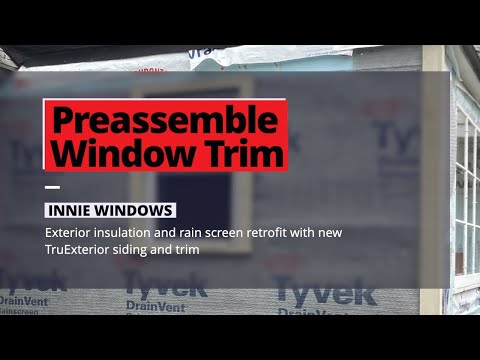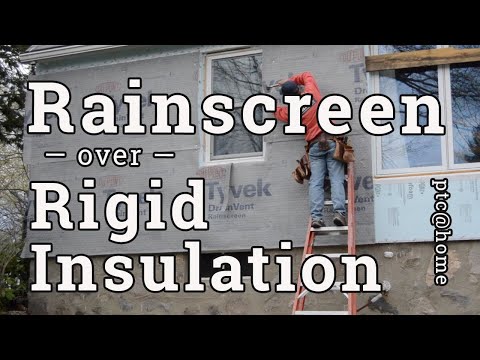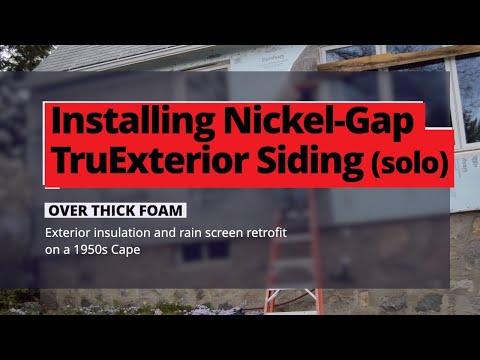The first step of installing BORAL TruExterior siding is unloading it from the truck.
The second step is installing Boral TruExterior trim, and the first step of installing TruExterior trim is planning, which means deciding what size trim to use where, and figuring out what it will look like.
I began by blocking out the house in SketchUp and trying different trim sizes and placements. In this drawing, there’s a continuous band across the head of all windows. I decided not to do that, though.
I did add a skirtboard to the bottom of the walls, and wide corner and casing profiles.
I like the greek revival look that a lot of simple New England houses roll into their designs, so I decided to mimic that to some extent.
Truexterior trim has a few cool details and extras
The skirtboard has a beveled top to deflect water out and away and a built-in kickout strip to hold that first piece of bevel siding out from the wall.
So there’s no flashing required atop the skirt.
Also, the whole wall system is designed to drain any liquid water out through the rainscreen. So anything that gets in will fall down behind the siding and trim and drain out the bottom of the wall.
Because I have not been a professional remodeler for almost two decades, I used a test wall to roll through the system before tearing all of the siding off the house.
When I had a system, I moved to the money wall.
Basically, there’s a skirtboard, corners, window trim, and utility blocks.
I began with the skirtboard, though some people begin with the corners.
The shirt is mitered at each corner and I used 18-inch scraps to set the positions correctly.
Before getting too carried away, I always check to make sure my saw is cutting square.
Speaking of square, always trim the ends of boards before pulling a measurement. They are not necessarily square right out of the factory.
I covered the bottom of the exterior styrofoam with site-bent coil stock, and leveled with a Builder’s Level, you know, the old-fashioned telescope-looking things we used to use before we had “Lasers.”
So I used the site-bent coil stock as a guide for leveling the skirtboard.
The skirtboard can go up before or after the corners
I used a mitered scrap on one end, and either a loop of rope or one of my kids at the other to position the skirt in place, and then I rechecked the level before screwing off.
The instructions call for two fasteners every 16 inches for boards under 10 inches, so that’s what I did.
Ideally, all of the skirts go up before moving to the corners, but because I needed to produce this video series, I worked out the system on the test wall outside my office and then focused on the large back wall of the house for video purposes.
I guess another thing worth noting is that this stuff is very easy to trim, carve, and shave with a utility knife. And that feature came in handy often.
With the skirtboard in place on the video wall, I fixated on the corner boards.
Corners come pre-built or can be site-built
I preassembled the corners using pocket screws spaced every 16-inches or so.
The main issue with installing the skirtboard first, the bottoms of the corners need to mimic the profile of the top of the shirt.
That means mitering the bottom of the corners and modifying the top of the skirt slightly.
This could be one reason to install the corners first.
Because there are only six corners on this house, it was not a big deal to do some custom work.
The corners are also fastened with two screws every 16 inches, but because two inches of foam pad the outside of the walls, you need to think about the fastener placement.
Another option is to weave in a ¾ inch plywood backer into the foam, but I just trusted my aim.
Now, with the skirt board and corners set, the only thing between me and siding is window trim and utility blocks.
Preassemble the window trim before installing it to the wall
Next, I trimmed out the window, incorporating deep exterior extension jambs to cover the foam edges and butt the window. I installed the jambs to the sill and the casing to the jambs, and then fastened the trim to the wall through the casing.
We covered this process on PTC years ago with David Joyce in Massachusetts.
He says that the extension jambs do not need to be watertight because the drainage plane behind them is watertight, and the windows are watertight.
Also, the rainscreen allows any water to drain out right away and to dry after the rain.
I believe him, but I went ahead and caulked the joints after the window trim was installed.
I’ll cover that whole window trimout process in a more detailed and focused video, but right now I’m gonna stick this block on the wall.
And this block.
And this block.
Like with the corners, I beveled the button of the block so it would slide down and flush out with the skirtboard.
I test-fit the exhaust hood, to make sure I could seal it up, and when everything seemed as it should be, I painted the block and took a break. Now, I can install the nickel gap TruExterior siding, which we prefinished while it was sitting on the work table.
ptc@home is a video series in which you can watch the editor of protradecraft remodel his house and heckle him on social media. This is the fourth segment of the series.











